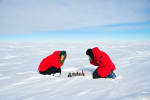IceCube isn’t the only neutrino experiment in Antarctica. There is also the ANITA (the ANtarctic Impulsive Transient Antenna) experiment, which flies a balloon over the continent and points radio antennae toward the ground in search of extremely high-energy neutrinos.
The IceCube Collaboration recently followed up on events detected by ANITA and presented their results in a paper submitted today to The Astrophysical Journal. The collaboration found that these neutrinos could not have come from an intense point source. Other explanations for the anomalous signals—possibly involving exotic physics—need to be considered. […]









